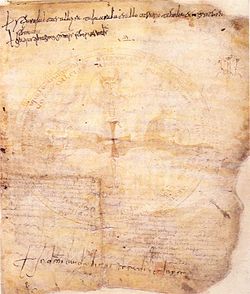| Veronese Riddle | |
|---|---|
 Original text | |
| Full title | Indovinello Veronese (Italian) |
| Language | Late Vulgar Latin / Early Romance |
| Date | 8th or early 9th century |
| Provenance | Verona, Italy |
| Genre | Riddle |
| This article is part of the series on the |
| Italian language |
|---|
| History |
| Literature and other |
| Grammar |
| Alphabet |
| Phonology |
The Veronese Riddle (Italian: Indovinello veronese) is a riddle written in late Vulgar Latin, or early Romance, on the Verona Orational, probably in the 8th or early 9th century, by a Christian monk from Verona, in northern Italy. It is an example of a writing-riddle, a popular genre in the Middle Ages and still in circulation in recent times. Discovered by Luigi Schiaparelli in 1924, it may be the earliest extant example of Romance writing in Italy.[1]
Text
[edit]The text, with a literal translation, runs:
Se pareba boves |
He led oxen in front of him |
Explanation
[edit]The subject of the riddle is the writer himself: the oxen are his fingers which draw a feather (the white plow) across the page (the white field), leaving a trail of ink (the black seed).
Origins of the Indovinello
[edit]The Riddle was written on codex LXXXIX (89) of the Biblioteca Capitolare di Verona. The parchment, discovered by Schiapparelli in 1924, is a Mozarabic oration by the Spanish Christian Church, probably written in Toledo. From there it was brought to Cagliari and then to Pisa before reaching the Chapter of Verona.
Text analysis and comments
[edit]Though initially hailed as the earliest document in a vernacular of Italy in the first years following Schiapparelli's discovery, today the record has been disputed by many scholars from Bruno Migliorini to Cesare Segre and Francesco Bruni, who have placed it at the latest stage of Vulgar Latin, though this very term is far from being clear-cut, and Migliorini himself considers it dilapidated. At present, the Placito Capuano (960 AD; the first in a series of four documents dated 960-963 AD issued by a Capuan court) is considered to be the oldest undisputed example of Romance writing in Italy.
The text displays some, but not all of the phonetic and grammatical changes that occurred between Latin and Standard Italian. The verbs pareba, araba, teneba, seminaba show the phonetic loss of word-final -t, as in Italian pareva, arava, teneva, seminava (from the Latin imperfect forms parebat, arabat, tenebat, seminabat). As in Latin, the neuter plural ending -a is found on both the noun and adjective in alba pratalia. This contrasts with the grammar of Standard Italian, where the plural ending -a was retained only for a relatively small number of nouns, which now trigger feminine plural agreement in -e on associated adjectives. However, this Italian development is not found in all vernacular Romance languages of Italy: some retain -a as a neuter plural ending used in both nouns and adjectives. The text uses albo versorio and negro semen where Classical Latin would have album versorium and nigrum semen. The replacement of Latin -um with -o is consistent with regular phonetic developments in Late Latin and Romance (loss of word-final -m and a change of /u/ to /o/), but could also indicate loss or weakening of the grammatical case distinction between the accusative and ablative cases (in Classical Latin, the same phrases would have the forms albo versorio and nigro semine in the ablative case). The form boves is identical to the Latin accusative masculine plural form, rather than displaying the vocalic plural ending seen in modern Standard Italian buoi. Michele A. Cortelazzo and Ivano Paccagnella say that the plural -es of boves may well be considered Ladin and therefore a genuine Romance plural rather than a Latinism.
In terms of vocabulary, the term versorio for "plough" can be found in today's Veronese dialect (and other varieties of the Venetian language), just as the verb parar is still the word for 'push on', 'drive', 'lead' (Italian, by contrast, has spingere, guidare). Albo 'white' is found in Old Italian[citation needed], in competition with the Germanic bianco which eventually ousted it from its place in everyday speech in most of Italy.
See also
[edit]References
[edit]- ^ "Le origini della lingua italiana". Archived from the original on May 7, 2006. Retrieved April 18, 2007.
- Notes
- Bruno Migliorini, Storia della lingua italiana. Firenze, Sansoni, 1987.
- Aldo Giudice, Giovanni Bruni, Problemi e scrittori della lingua italiana. Torino, Paravia 1973, vols.
- AA.VV. Il libro Garzanti della lingua italiana. Milano, Garzanti, 1969.
- Lucia Cesarini Martinelli, La filologia. Roma, Editori Riuniti, 1984.
External links
[edit]- (in Italian) Indovinello Veronese